I vote best piks ever in the history of SB! How is it that in todays mentality, you ignore, shun, and forget history? When it is the single most important source of learning we have? One should have a keen sence of ones past, to understand fully where you are. The great informed may be surprised to know that the basis of thier "new" knowledge was discovered, and practiced, years before many of them were concieved. Sorry to stir the pot of ignorance.... But to see the future? Look into your past. History really does repeat itself.
You are using an out of date browser. It may not display this or other websites correctly.
You should upgrade or use an alternative browser.
You should upgrade or use an alternative browser.
Inexpensive Doubles
- Thread starter JohnW
- Start date
Please register or login
Welcome to ScubaBoard, the world's largest scuba diving community. Registration is not required to read the forums, but we encourage you to join. Joining has its benefits and enables you to participate in the discussions.
Benefits of registering include
- Ability to post and comment on topics and discussions.
- A Free photo gallery to share your dive photos with the world.
- You can make this box go away
nereas
Contributor
- Messages
- 2,735
- Reaction score
- 10
- # of dives
- 500 - 999
The 72s themselves are the most valuable part of this package. I love 72s.
I would start with paint stripper from the hardware store, however, and strip them back down to their natural metal.
Then a new manifold and double bands. I think history is great, but at the same time I would not go diving in a diesel submarine either.
I hope that does not sound mean. Its just that I prefer two of everything, as long as I have doubles on my back anyway.
I would start with paint stripper from the hardware store, however, and strip them back down to their natural metal.
Then a new manifold and double bands. I think history is great, but at the same time I would not go diving in a diesel submarine either.
I hope that does not sound mean. Its just that I prefer two of everything, as long as I have doubles on my back anyway.
Soggy
Contributor
dbg40:I vote best piks ever in the history of SB!
Yes, very cool pictures, John!
How is it that in todays mentality, you ignore, shun, and forget history? When it is the single most important source of learning we have? One should have a keen sence of ones past, to understand fully where you are. The great informed may be surprised to know that the basis of thier "new" knowledge was discovered, and practiced, years before many of them were concieved. Sorry to stir the pot of ignorance.... But to see the future? Look into your past. History really does repeat itself.
What is it that I'm going to learn from procedures and equipment from the 60s and 70s that is going to help me be a better diver? It is irrelevant to me that the knowledge that was taught to me is "old" or even what the history of the knowledge is. It is the knowledge itself that matters. The act of breathing off a double hose regulator or understanding how they work does not make me a better diver.
I do know a lot of this history, by the way, and do know where a lot of the procedures and gear we use comes from. None of it matters to my diving at any practical level. The equipment we use now is very different from what was used then, for a number of reasons (none of which are related to making less reliable gear in order to sell more gear
Many people find it interesting for what it is. That's great. We all have different interests and I have a lot of respect for people's expertise in different areas of any field or sport.
First, I forgot that some people may not know who Frederic Dumas is; he was one of the original divers who pioneered diving with Jacques Cousteau, and was the safety diver when Cousteau waded into the Villa Barry cove to test the very first Aqualung in June of 1943. According to Cousteau, "Dumas, the best goggle diver in France, would stay on shore keeping warm and rested, ready to dive to my aid, if necessary." It wasn't necessary, as Cousteau had a ball with his first Aqualung dive, and that started everything we know of today.Soggy:Yes, very cool pictures, John!
What is it that I'm going to learn from procedures and equipment from the 60s and 70s that is going to help me be a better diver? It is irrelevant to me that the knowledge that was taught to me is "old" or even what the history of the knowledge is. It is the knowledge itself that matters. The act of breathing off a double hose regulator or understanding how they work does not make me a better diver.
I do know a lot of this history, by the way, and do know where a lot of the procedures and gear we use comes from. None of it matters to my diving at any practical level. The equipment we use now is very different from what was used then, for a number of reasons (none of which are related to making less reliable gear in order to sell more gear).
Many people find it interesting for what it is. That's great. We all have different interests and I have a lot of respect for people's expertise in different areas of any field or sport.
Soggy, let me take the first bolded statement, and make a comment or two. You say that the equipment that you use now is very different than in the 1970s. That's not really the case. We had "modern" regulators then too. As a matter of fact, I've now got two of the original Calypso regulators, with the exhaust in the diaphragm, and they breath exceptionally well for inhalation resistance. Because of the smaller exhaust, they do not breath as well as today's regulators, but are actually better than the second generation Calypso (though more expensive to manufacture). Here's what it looked like:
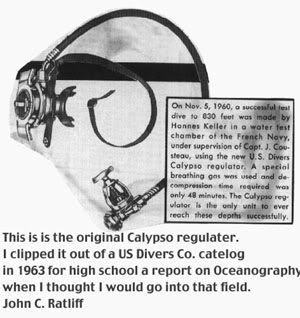
But we had single hose regs with octopus and SPGs in the 1970s, and dove them in our "technical" diving of the time (cave, for me). Here's a photo I took in 1973 of our archeological diving when I was helping a fellow named Murphy and Sonny Cockrell in the Warm Mineral Springs Underwater Archeological Project in Florida:
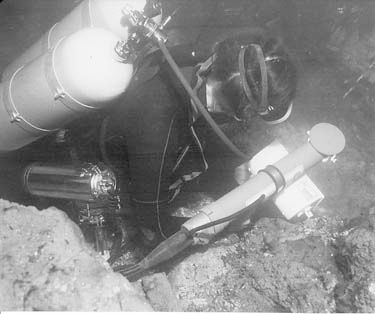
Note that we are using twin 80s, with single hose regs and octopus on the regs (some cave divers had progressed to the twin post manifolds, but since we were not penetrating inside the cave, only deep diving (~210 feet), we decided that octopus regs worked well. We did have a Poisiden regulator fail when we had a senator from Florida diving with us, and it was his reg that failed. Fortunately, this senator was also an ex-Navy SEAL, and he simply swam over to his buddy diver and used his octopus for the duration of the dive.
So how will diving vintage help someone in their every day diving. Well, you cannot use dive computers and dive vintage, for instance. You would have to learn the tables, and have them available during the dive (plastic tables) to compute no-decompression limits or decompression times. This could save you money in not having to have two different dive computers, in case one craps out on you during a dive. You could simply go to your waterproof tables, and your watch (you do have a dive watch, don't you?), and compute your decompression/no-decompression.
You could also understand that control of buoyancy with wet suits occurs in the first 35 feet of water. I proved this years ago by diving Clear Lake, and at 35 feet, taking off my weight belt. It was some of the most un-emcombered diving I have ever done.
So far as double hose regulators go, you could find a direct application if you, like me, enjoy underwater photography. Little critters tend to be skittish when you blow bubbles out of your face. If they are behind your back, then they don't see it (especially if they are small invertebrates and fish). It makes underwater photography much easier. For instance, you may even get to coax a three-spined stickleback between the macro ring framer while still breathing if you use a double hose regulator:
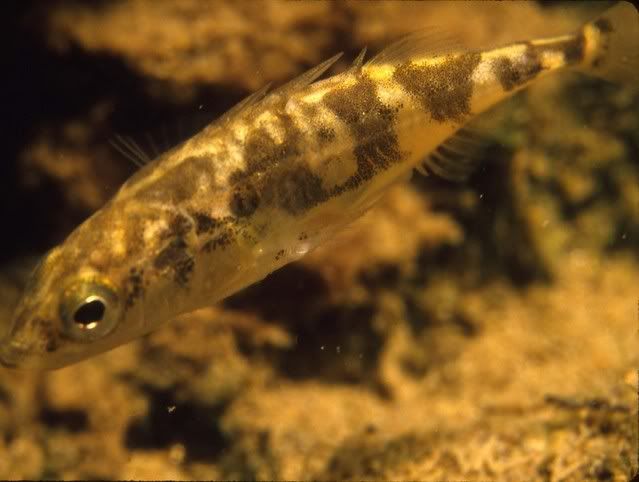
I notice from your avitar that you use the "frog" kick. This kick was developed for cave diving, and is a rather inefficient way of locomoting underwater (just as the breast stroke will never be as fast as freestyle in competitive swimming). This "frog" kick is used to keep moving while not stirring sediments on the bottom of caves, so the kick originates and concludes above your horizontal live. Some feel it is a neat way of swimming; I see only the inefficiency of the kick (and I know kicks, as I was at one point Finswimming Director for the Underwater Society of America). The most efficient kick for underwater finswimming is the dolphin kick, with your hands extended in front of you in a streamlined manner.
Small double tank systems have a place in some diving. Here is a photo of me diving Clear Lake (one of my favorite areas) with the small double "jump tanks" I put together in the 1970s (and drilled when they became unsafe in the 1980s).
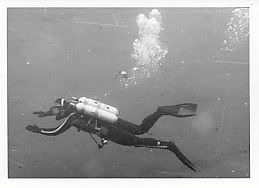
The twins are easy to handle, easy to swim with in the water, and very nicely balanced.
I say "jump tanks," as that is what they are. In the USAF, we used them for parascuba jumping, but I would not expect regular divers to try this. Here is one of our jumps off Okinawa in 1968:
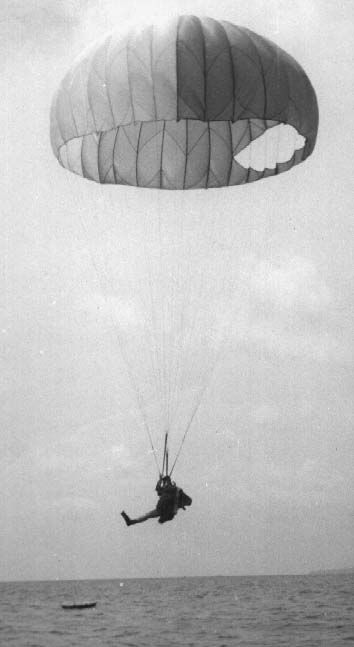
During these jumps, we used J-valved doubles with a manifold guard, had a reserve parachute (redundency, you know), a single hose regulator that was a single hose regulator, a "butt boat" or one-man life raft in a square container hanging off our rear, and sometimes a medical kit under the reserve parachute.
Pararescue jumps differently these days, without scuba, and they push a container out of the aircraft which contains their survival gear, scuba (if needed), medical gear, etc., all wrapped within a Zodiac with its 59 hp motor. They do HALO jumping with the container (high altitude, low opening), pull the chute on their boat first, and then pull their own chutes.
So some of the old ways have direct application, and some don't. But at least you learn to get along without all that gear at times.
Now, about that gear being so very different. Configurations may be different; they may also be much less streamlined than in my younger days, which makes swimming so much more difficult that I can see why you would enjoy the scooters.
But if you look at the gear, specifically the regulator first and second stages, you'll see that while there are some refinements, they are much the same as forty years ago. Most regs have a separate exhaust valve away from the diaphragm. If this is the case for your regulator, it has an inhalation breaking resistance of about 3/4 inch of water, or in some positions it would leak air. This, by the way, was the basis for Cousteau's patent, that the exhaust and the diaphragm must be close together to avoid leaking air. Because of this limitation, cracking resistance cannot by definition be better than 40 years ago, as they must both contend with the same physics problem of differential water pressure.
Fins have not improved that much in the last number of years. I have a pair of home made fins that still beats today's fins, and I developed them in 1968--the scoop fin:

It is based upon this patent:
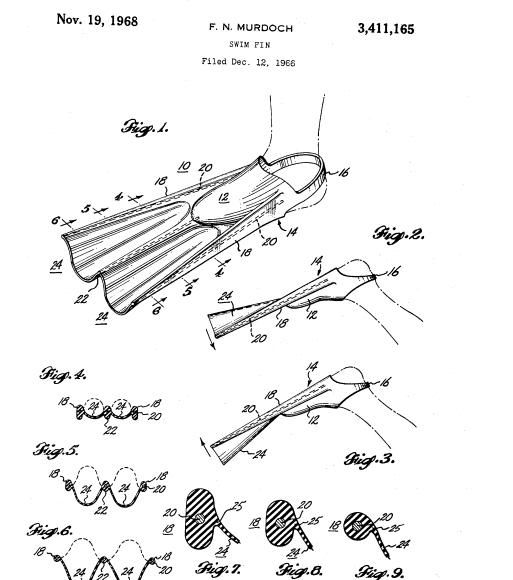
I tested it in Florida's Alexander Springs State Park...
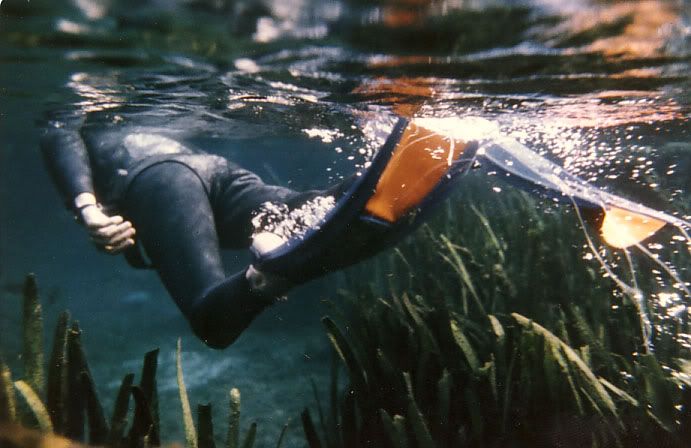
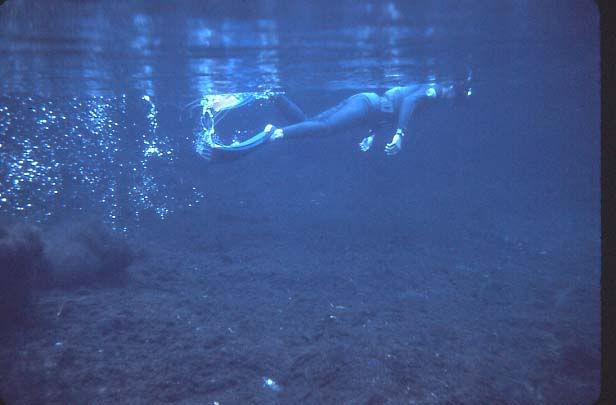
...and continue to dive my own version today:
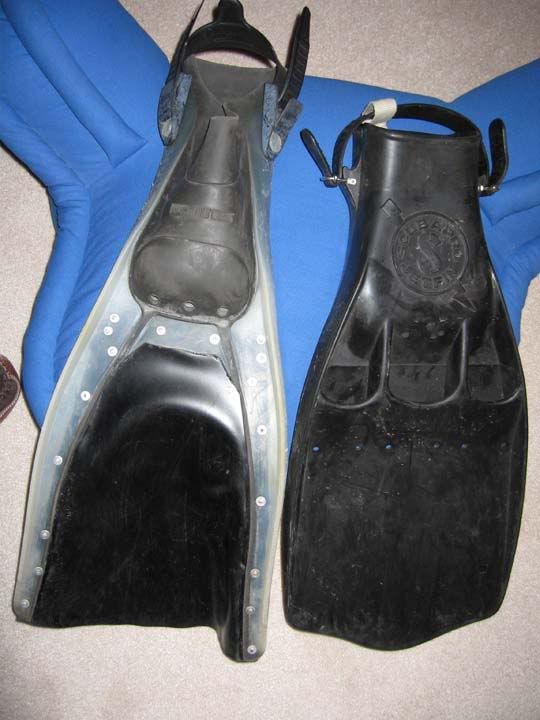
Mares has now come close, but still has not got the concept down correctly.
SeaRat
nereas
Contributor
- Messages
- 2,735
- Reaction score
- 10
- # of dives
- 500 - 999
Plus, ...
nereas
Contributor
- Messages
- 2,735
- Reaction score
- 10
- # of dives
- 500 - 999
Plus, you live up in Oregon, SeaRat, where your historical stuff is still state of the art.

nereas
Contributor
- Messages
- 2,735
- Reaction score
- 10
- # of dives
- 500 - 999
I know ... I will get the memo from TSM in the morning.
Sorry, I couldn't resist, mate! (as Capt Jack Sparrow said in Pirates 1.)
(Now, where did I park that diesel submarine? Oh yah, its in the parking lot, right where I left it.)
Sorry, I couldn't resist, mate! (as Capt Jack Sparrow said in Pirates 1.)
(Now, where did I park that diesel submarine? Oh yah, its in the parking lot, right where I left it.)
Well, I haven't bought new gear in a while now.nereas:Plus, you live up in Oregon, SeaRat, where your historical stuff is still state of the art.
I do like the inexpensive doubles that were posted here, they are really beautiful. Twin 72s are a great way to dive if you don't mind the weight, or have someone who can heft them to the water for you.
SeaRat
I don't care about history either that much, I dive vintage/eclectic gear because it is more functional, more reliable, safer, more durable. I prefer the methods taught long ago because they were more dependent upon self reliance and harmony with the underwater world. Modern divers rely to much on crutches, equipment and buddy skills, are mostly under trained and arrogant and generally not very skilled. Of course, there are always exceptions.
N
N
Soggy
Contributor
John,
I understand where you are coming from (and keep the photos coming!), but you sort of reinforced my point (at least, to me). None of the historical context of all the techniques that you described is important. I was taught to use tables and to use all sorts of different methods to calculate decompression profiles without a computer. I use a frog kick because it is more efficient underwater (dolphin kicks don't work too well with a full tech setup). Though I don't choose to do it, I know I can dive without a BC because I don't put any gas in my wing when diving smallish single tanks. I use a long hose because it works well in the environment I am in, etc, etc. The *history* of all that doesn't really matter. What matters is the knowledge and technique *itself*.
I'm not suggesting that we can't learn from those that came before us...quite the contrary. For example, It is enough to know that the 5 rules of cave diving (and their order) were developed because people died. Not much more is necessary. Though I happen to have some knowledge about it, I don't *need* to know anything about the gear they were using, who developed it, what year it was made, etc.
From what I can tell, vintage diving is niche that people gravitate to for a number of reasons, but I don't believe that there is a lot to be learned from it to apply to modern diving.
I understand where you are coming from (and keep the photos coming!), but you sort of reinforced my point (at least, to me). None of the historical context of all the techniques that you described is important. I was taught to use tables and to use all sorts of different methods to calculate decompression profiles without a computer. I use a frog kick because it is more efficient underwater (dolphin kicks don't work too well with a full tech setup). Though I don't choose to do it, I know I can dive without a BC because I don't put any gas in my wing when diving smallish single tanks. I use a long hose because it works well in the environment I am in, etc, etc. The *history* of all that doesn't really matter. What matters is the knowledge and technique *itself*.
I'm not suggesting that we can't learn from those that came before us...quite the contrary. For example, It is enough to know that the 5 rules of cave diving (and their order) were developed because people died. Not much more is necessary. Though I happen to have some knowledge about it, I don't *need* to know anything about the gear they were using, who developed it, what year it was made, etc.
From what I can tell, vintage diving is niche that people gravitate to for a number of reasons, but I don't believe that there is a lot to be learned from it to apply to modern diving.
Similar threads
- Replies
- 10
- Views
- 2,200
- Replies
- 8
- Views
- 1,554
- Replies
- 12
- Views
- 2,094
- Replies
- 3
- Views
- 1,288
- Replies
- 2
- Views
- 1,021



